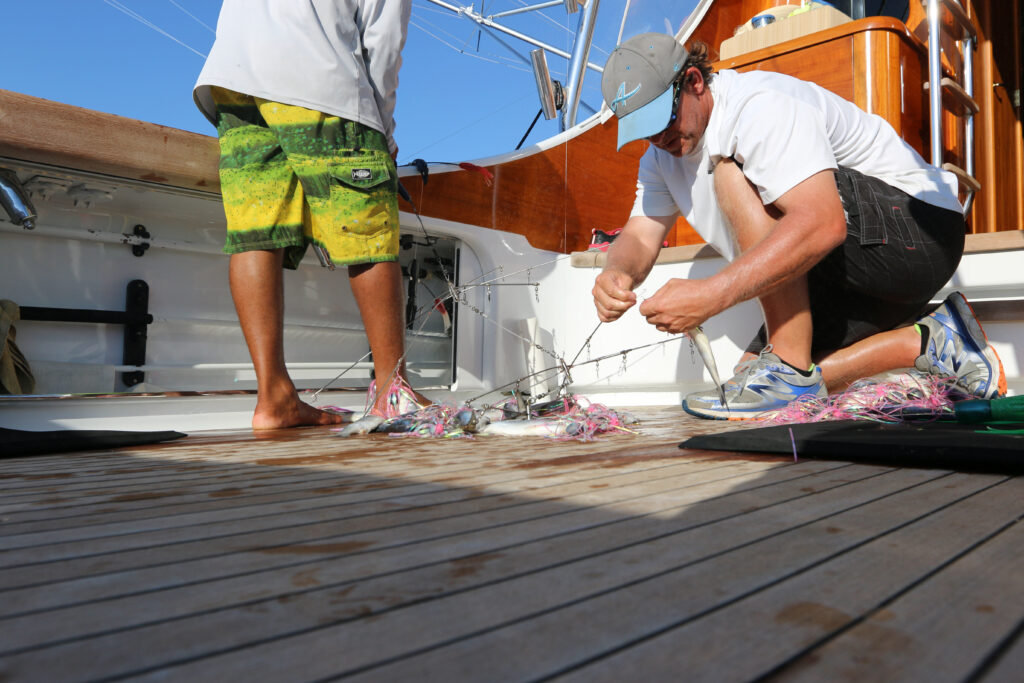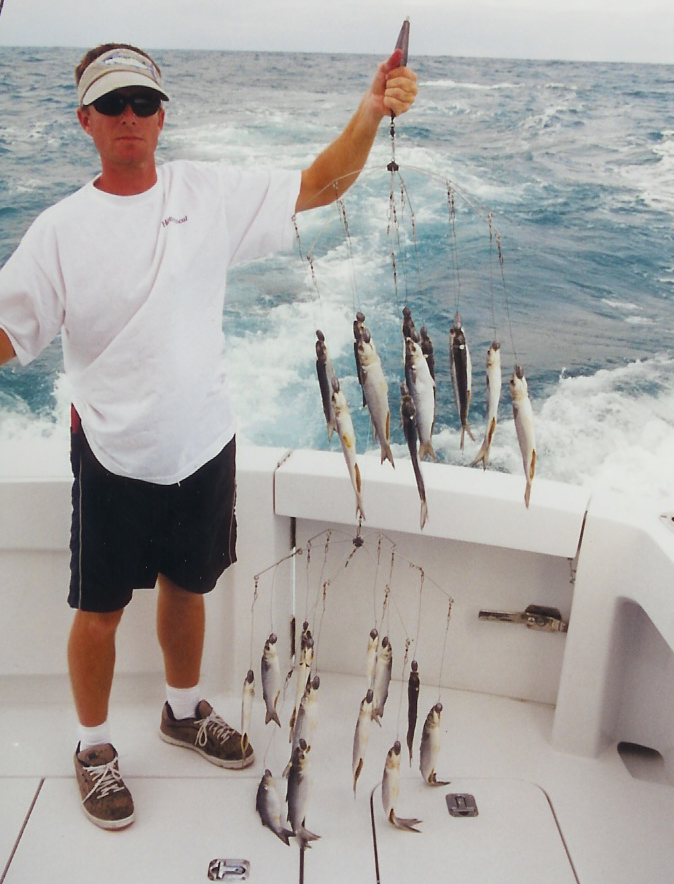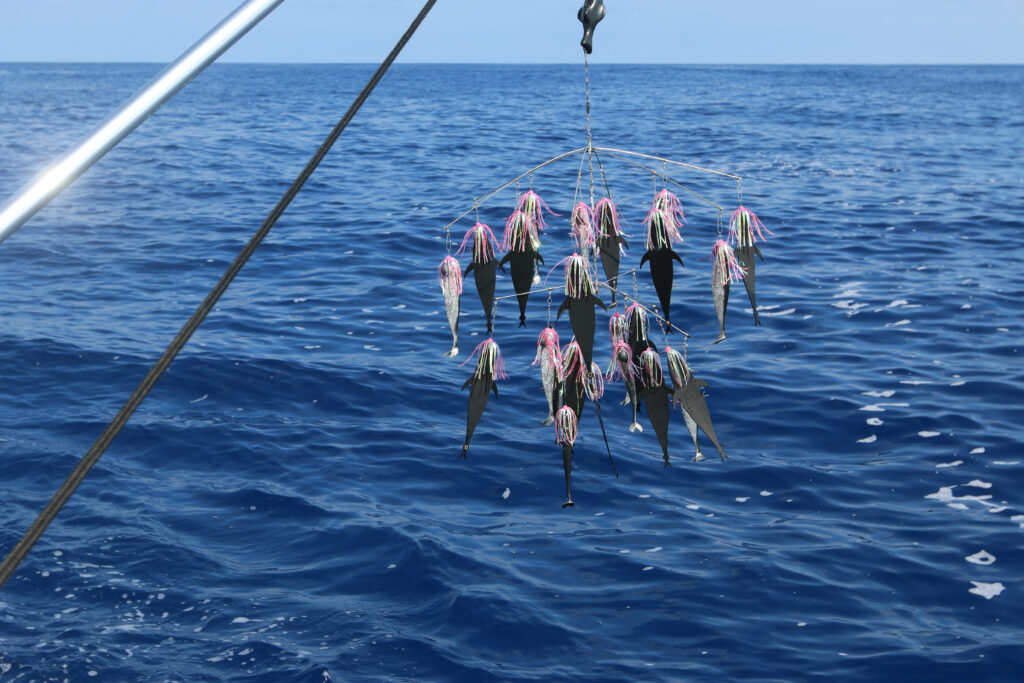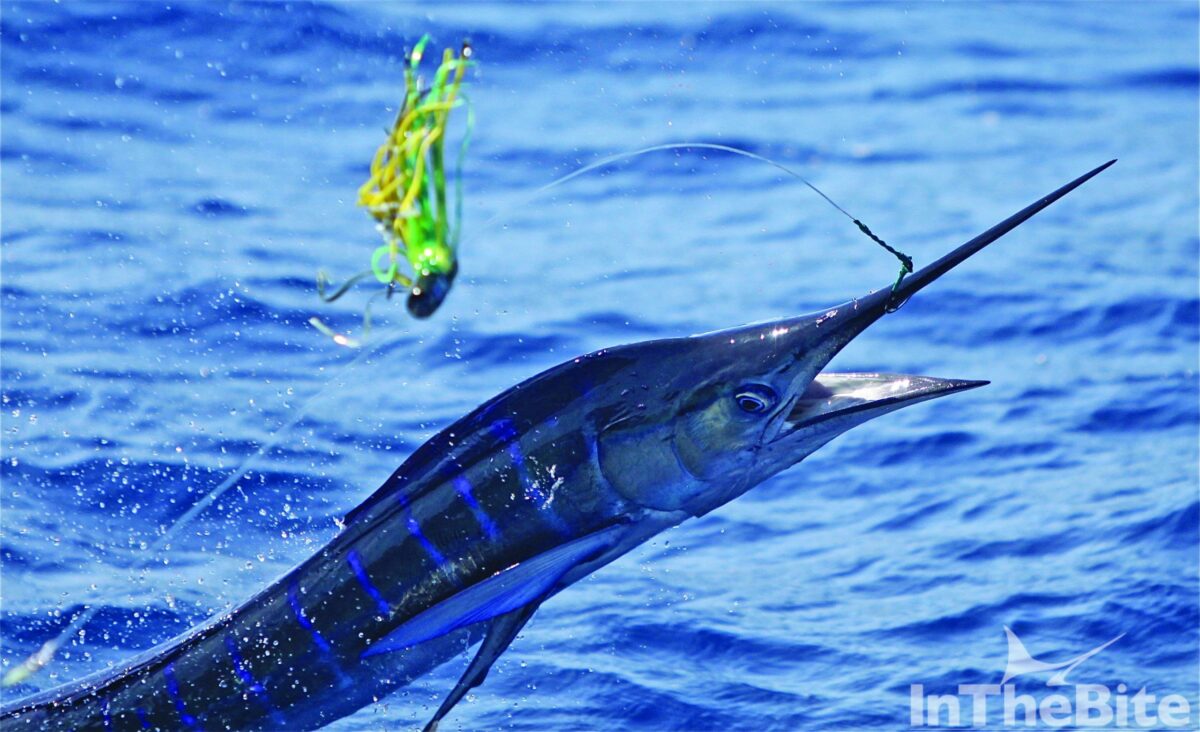I hate dredges. Yeah, I wrote that. Mainly, because I’m lazy. Oh, there’s no arguing about their effectiveness in the world of “How Dredge Fishing for Billfish Revolutionized the Sport”. I wouldn’t get caught dead bait fishing in any billfish tournament from here to Timbuktu without dredges. But dang it, they sure can be a pain in the ass at times! Preparing all those baits every morning during the chilly (for us Florida boys anyway) winter sailfish season isn’t a lot of fun.
Dipping your hands in ice water to retrieve your baits, opening and closing snap swivels, and injecting tiny bits of salty water and mullet slime into your hands or fingers every time you poke yourself with a piece of sharp wire becomes a time-sucking chore. That’s especially true if you’re rigging and making spares for double or triple, six-armed dredges which require 100 baits or more.
Throw in a few marauding bonitos, barracuda, or an ocean full of weeds, and the dredge can quickly become a hindrance rather than an asset. You end up spending more time replacing baits and shagging weeds than you do fishing. But it has to get pretty bad before you start to think about bringing them in; that’s just how good they work!
Trolling along with one or two of your very own bait balls tucked up under your tail and well below the wash quickly draws a look from any self-respecting billfish in the vicinity, regardless of species. And since all these pelagic predators feed primarily through sight, a dredge’s large profile and pulsating action rings the instinctive dinner bell and triggers that primordial chase that we hope to turn into a bite.
Table of Contents

The Evolution of Dredge Fishing: From Early Days to Modern Marvels
While these words might be what every guest on Maury Povich wants to hear, I was a bit saddened when legendary Capt. Chip Shaffer told me unequivocally, “Dave, I am not the father of the dredge! It’s a common misconception. The first time I was exposed to the dredge was through Capt. Dave Berard.”
I was one of many who thought Shaffer was one of the first guys to ever troll a dredge for sailfish. Turns out, he was just one of the first guys to make them famous. A quick call to Berard, now a yacht broker at HMY in Port Salerno, Florida, confirmed Shaffer’s denial, as he laughed and said, “Yeah, we probably got away with using it for three years before anyone else found out about it! Chip was still a daisy chain fisherman at that time until one of his mates saw what we were doing.”
Berard went on to say that he wasn’t the first one to use a dredge for sails either!
“The first guy that started it all was Capt. Barry Kohlus from Montauk, New York,” he said. “I first saw Barry pulling a dredge during the Gold Cup and Masters tournaments, fished out of the Sailfish Club of Florida in Palm Beach. Kohlus was running a Brownell boat called “Penade”. He had taken a four-bar, bluefish umbrella rig and he put four black mullet on it.”
We were there, saw it, and modified it,” Kohlus continued. “We put silver mullet on and combined it with the five mullet chain down the middle. We took the little umbrella rig and fished the tournaments and charter fished out of Stuart. We did really well with it before anyone else had one. One day, my mate couldn’t fish with me, and we took another guy out. This was 40 years ago. At that time, you’d kill fish for mounts, so I was asking myself, ‘should I show this kid the secret umbrella rig?’ Well, we did show him and we caught six sails with four customers ordering mounts. The secret was out.”
It worked so well that word of mouth spread. “It just kept growing and growing and growing,” Berard added. “I don’t think there’s a boat that fishes tournaments these days that is not pulling a triple dredge. Nothing works like a dredge to attract sails. They are probably the most popular teasers there ever were, and I don’t think anything will ever replace them.”

Dredge Fishing Spreading Around The World
Another guy who gets a lot of credit for perfecting the dredge, Capt. Jimmy Grant, was freelancing as a mate during the mid-to-late 80s, jumping from boat to boat during the tournament season. But the fleet was so secretive, Grant didn’t even see his first dredge until 1989.
“I know the very first time I saw one I was fishing with Capt. Dave Dotterweich, on the Fish Hawk, a 47-foot Buddy Davis,” Grant said. “I was an observer and Jimmy Fields was the mate. It was a four-arm dredge loaded with four Charlie Hayden tuna mullets, the big ones that they used to catch tuna on in Cat Cay that you don’t see anymore.”
While that first exposure to the dredge made an impression, it didn’t blow up until a little while later. “We didn’t start using it all the time until a few years after that first time I saw one. The dredge was pretty much just a Florida thing. We would fish them down in Mexico as well, but for whatever odd reason, we didn’t incorporate them into the Northeast for years after,” he adds.
Grant says that by the mid-90s, while he was still freelancing on different boats during the Mid-Atlantic tournaments and in Oregon Inlet, he started seeing the dredges making their way into the spread. “In 1995 I was freelancing on the “Whopper Stopper” during the white marlin tournaments and we crushed everyone while pulling a dredge. We were in the middle of the fleet during the fall tournament and the white marlin were eating us up!” says Grant.
“Then the next year, I took a dredge down to Venezuela to fish with Capt. Pedro on the “Guarimba” with Hans Kraaz, and we did very well,” he added. “The following year I went back down there with Chip to fish in Richard Gibson’s Venezuelan Grand Slam tournament and we were using a synthetic dredge with rubber minnows. That turned out to be extremely productive. That was the sonar of the day. It was a big advantage for us because nobody had them down there.”
“They definitely improved our catches,” says Shaffer. “You could see the fish come up to them and then our flat lines and teasers started getting a lot of play. These were not the 60- or 100-mullet setups you see nowadays; these were the four-arm dredges with just 12 or 15 baits … singles. We would pull them on the same downriggers we would use for mackerel fishing, Penn Fathom Master. They were sturdy. We pulled a #24 planer on them when mackerel fishing, and we would hand-crank through a pulley. Our teaser reels at that time were usually old reels that had got so bad we couldn’t use them for fishing anymore!”
While the downrigger system got the dredges down and kept them there, it was cumbersome and didn’t allow you to get the dredge out of the water when necessary. “It definitely led to some disasters,” says Shaffer. “If a blue marlin inhaled a dredge bait, that was it. We found early on that it was not adequate. You couldn’t move it out of the way. And if for some reason you were to lose one, $1,000 worth of gear goes plummeting to the bottom, so you better have a backup. We were still trolling by and large and weren’t doing a lot of pitch-baiting. If the bonito got really bad, we would go to all teasers. We always had a squid rigged to pitch to a blue marlin.
“One of the biggest changes I noticed at that time was that before the dredges came, you’d spend a couple of hours getting your baits ready and about 10 minutes on the teasers,” Shaffer added. “Now, it’s the opposite. The mates spend most of their time with their head in a bucket rigging mullets for the dredge.”
Innovations in Dredge Fishing: Natural vs. Artificial Baits
There’s no shortage of innovation in the sport of big game fishing. So, it wasn’t long before those four-armed, 12 natural-bait dredges began to evolve into bigger and bigger bait balls. Six-arm, and then eight-arm dredges became the norm. Then, crews started doubling or tripling them up, running one behind the other, with 75 baits or more on each side.
Crews also found that they could substitute artificial baits and colored skirts to add additional flash and action, while at the same time saving on weight, rigging time, and the extra expense of using dead baits. Barad says that some of the first artificial baits he put on his dredges were Capt. Sam Crutchfield’s Jelly-hoos. An inexpensive, plastic ballyhoo imitator. Shaffer even experimented with lipped plugs with the hooks removed and rubber baits like the Sassy Shad.
Iland Lures, and Sea Witches of all sizes and colors also became popular ways to add color and flash. My good friend Walker Holcomb created a very expensive Iland Lure dredge made from 50 mylar Ilander Trackers he called a Crystal Dredge. It was beautiful, right up until we lost it. Iland Lures now makes special dredge lures with extra weight and space for additional hardware.

Captain Insights: Using Dredges Effectively in Tournaments
Capt. Jay Weaver, on the Blue Sky, 60’ Spencer out of Georgetown, South Carolina, [InTheBite’s 2022 East Coast Captain of the Year] says he can’t think of a time when he was not using a dredge. “I pulled my first one in 2001,” Weaver said. “A mate on the Sound Machine showed me how to rig the mullet and put them on the bars. Then, Capt. Bobby Garmany and I on the Cookie Monster had a really good year of fishing with them. They made an obvious difference.”
Although Weaver still uses natural baits in tournaments, “we do mix in a lot more artificials now than we did 10 years ago,” he said. “We even get together at the beginning of the season to talk about what our dredge setup is going to be. I let the boys handle all of it. They are on the dock every day and all night, so they know what the other guys are seeing them on … big, small, artificials, dead baits, whatever. We usually go with a six-arm dredge, kind of medium size, with heavy-gauge bars. We switch out all our bars on tournament days because we like to have fresh, springy bars. We pull one set one day, and another set the next. They tend to get a lot of memory over time, and they might not ‘breathe’ or flex as much as the guys call it. Also, you’re less likely to break an arm if they are brand new. But we still manage to break a few.”
Capt. Landon Bell, out of Orange Beach, Alabama, [InTheBite’s 2022 Gulf Coast Captain of the Year] prefers the bait-and-switch aspect of dredge/teaser fishing because it’s a lot more fun for the anglers. “There’s a lot of excitement when you raise a fish and the anglers can see it and pitch a bait,” says Bell. “We also spend a lot of time experimenting with the makeup of our dredges, adding artificial baits to try to improve on them.”
But at the same time, Bell agreed with most of the other captains when he said he prefers using all naturals come tournament time. “I think the naturals are way better and make a big difference,” he said. “It’s definitely worth the time and effort to rig up natural dredges. When you are fishing in tournaments, every fish counts, so you want to catch those sails and white marlin too.”
No matter what kind of baits he has out, Bell isn’t concerned with slowing down to pull the dredges. “They do slow you down, and we are not pulling them super-fast,” he said. “Trolling them with one motor in gear seems to work pretty well and it just depends on what we are doing. We are not out trying to cover ground. Once the dredges are in the water we are in the spot where we want to be.”

Efficiency Matters: Electric Reels and Handling Heavy Dredges
With the dredges getting larger and heavier, it soon became evident that there had to be a better way of getting the dredges in and out of the boat besides cranking them in by hand. “The problems started when you got into the grass,” says Grant. “We were hand cranking them in with a downrigger setup from the cockpit. We called it the hand job! Cranking them in all the time to shag that grass was harder than pushing a button as the guys do now.”
That button Grant is talking about is usually attached to a Lindgren-Pitman electric reel these days. These powerful electric reels, in conjunction with a series of pulleys, can lift heavy dredges up to the surface in seconds. “We use the 24-volt LPs for our dredge reels,” says Weaver. “We like to pull them on 500- to 800-pound braided lines. The 800-pound braid is thicker than 400-pound mono and the 500-pound braid is thicker than 300-pound mono. The braid does a good job of keeping the dredge from getting cut off when a fish comes in on the side and gets in front of the dredge. It also pulls straighter and smoother. It doesn’t stretch so we get more action on the bars. Braid doesn’t jerk back and forth and yank the dredge around like mono can.”
Conclusion: The Enduring Success of Dredge Fishing for Billfish
No matter what you think about dredges, you certainly can’t argue with their effectiveness. “They produce great with today’s tactics,” says Shaffer. “The boys today are better than we ever were, but they won’t be as good as the guys coming up behind them. I think they could all outfish us, but I don’t think they are having as much fun!”
Don’t Forget to Check Out Our Sportfishing Job Board! Did You Know? It’s the perfect platform for seeking skilled captains and mates. Whether you’re on the hunt for your dream team or looking to join one, your next big adventure begins here. Explore the opportunities now! Click Here
Unlock a World of Sportfishing Excellence!
Love what you just read? Don’t miss out on more incredible content. Sign up for our e-newsletter today and get a FREE digital issue of InTheBite Sportfishing Magazine delivered to your inbox. Dive into the world of bluewater fishing and discover what you’ve been missing.
Join the InTheBite community now. Simply enter your name and email below and start your adventure.














